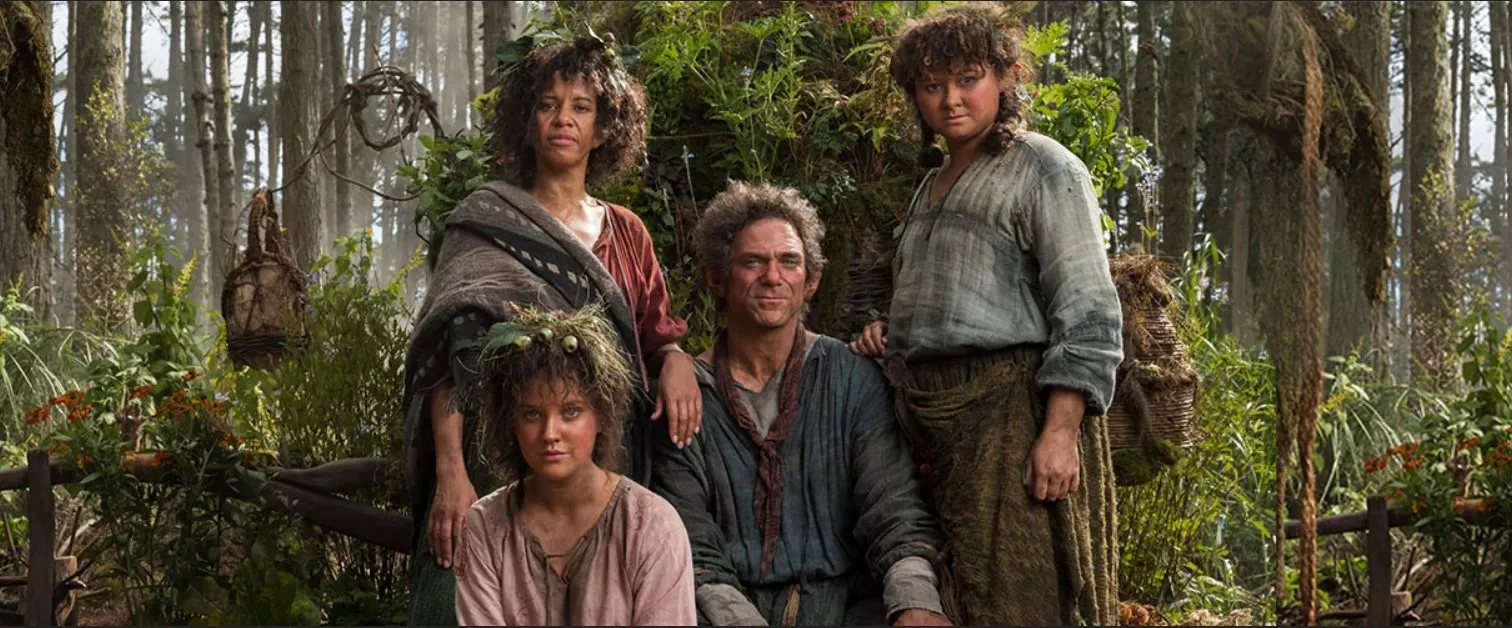Those who have read The Hobbit or The Lord of the Rings know that the books are filled with songs. Every dramatic adaptation has to decide how to handle this particular aspect of Tolkien’s writing – whether to include any of them, which ones to include, and how to perform them. Aragorn sings old Elvish ballads, Bilbo is a composer, the Dwarves have songs about their ancient mines, the Rohirrim love melancholic battle epics, and even goblins spontaneously break into song.
There are various stage musical adaptations of The Hobbit and The Lord of the Rings, with the most well-known being the version that premiered in Toronto in 2006 and ran for a year in the West End in 2007-2008. The composers were A. R. Rahman, Värttinä, and Christopher Nightingale, with lyrics by Shaun McKenna and Matthew Warchus. Since there are not enough of Tolkien’s songs in The Lord of the Rings to create an entire stage musical, most of the songs are original, but the show does incorporate several of Tolkien’s songs, as well as original lyrics written in the Elvish language Quenya.

The song that best captures the tone and essence described in the book is “The Cat and the Moon,” which is based on “The Man in the Moon Stayed Up Too Late” and inspired by the nursery rhyme “Hey Diddle Diddle” (which Tolkien notes that only a few words of it are still remembered). In the story, Bilbo wrote the “full” version of this song, and in The Prancing Pony, Frodo stands on a table and sings it to distract everyone from Pippin’s impending reveal of their true identities. The musical version initially retains the fun nursery-rhyme feel of the book, but soon turns into a rousing chorus number on stage.
Other songs directly inspired by Tolkien’s work keep many of the lyrics, but are reimagined to fit into the conventions of modern musical theatre. So while “The Road Goes On” is appropriately uplifting and “Lament for Moria” suitably mournful, they both feel like typical stage musical numbers with Tolkien’s lyrics attached, rather than fully capturing the essence of the songs as described in the books. This is a sensible approach for the medium, but it does make them feel less like the original songs.
In Ralph Bakshi’s 1978 animated version of The Lord of the Rings, which was intended to be Part 1 of 2 and ends abruptly at the conclusion of the Battle of Helm’s Deep, there are very few Tolkien songs featured. The only significant song is “The Man in the Moon,” which accurately captures Tolkien’s description of a bright and simple tune that pub-goers can easily clap along to. Overall, Bakshi wasn’t keen on including Tolkien’s music in his adaptation, and Bilbo recites poems instead of singing them in Rivendell. Bakshi even took a dig at the more musical animated film of The Hobbit directed by Arthur Rankin Jr. and Jules Bass that aired on television the same year, stating that his film “is not going to have any song for the sake of a record album,” according to The New York Times in 1977.
For a long time, many book fans preferred the 1981 26-episode BBC Radio 4 dramatization of The Lord of the Rings, written by Brian Sibley and Michael Bakewell, with music by Stephen Oliver. This adaptation features several of Tolkien’s songs set to music, some of which more closely resemble their descriptions in the books than others. “O! Elbereth Gilthoniel” has an early modern English Tudor influence that feels appropriate for the Elves. While some of the hobbits’ walking songs are a bit plodding and mournful, others are quite effective. The hauntingly beautiful song Bill Nighy as Sam sings without accompaniment to keep himself going in an Orc watchtower in Mordor is particularly noteworthy.
The most successful use of one of Tolkien’s songs in the radio adaptation is the “Ballad of the Mounds of Mundburg.” To dramatize a battle scene on the radio, the writers incorporated one of Tolkien’s songs from the book that he said was written by a Rohirrim singer after the battle, describing the deaths of several Rohirrim warriors, including Théoden. The song’s poetic ballad-like composition, with its rhythmic, chanting tone, was blended with battle sound effects and dialogue from the characters, allowing the audience to follow what’s happening in the battle and giving the scene a richer feel. It’s a clever and faithful adaptation of Tolkien’s song.
While the Peter Jackson Lord of the Rings trilogy did not feature many of Tolkien’s songs, a few were included and some were recited as poems instead of being set to music. Théoden recited the song “Where now the horse and the rider?”, originally chanted by Aragorn in the book. The hobbits’ songs were the closest to their book counterparts, such as Merry and Pippin’s drinking song, Bilbo’s “The Road Goes Ever On,” and Pippin’s “The Edge of Night.” However, the last song was transposed to a later scene, with some comedic or homely parts omitted, and Merry sang it with Pippin instead of Sam. “The Road Goes Ever On” was more faithful to the book, matching the description of Bilbo softly singing it to himself. The Extended Edition of The Fellowship of the Ring also included one of Tolkien’s songs, with Aragorn singing a quiet, unaccompanied song in Elvish about Beren and Lúthien that closely followed the book’s description of chanting an ancient lay.
The Lord of the Rings movies omitted “The Man in the Moon,” but it was later included in Peter Jackson’s The Hobbit trilogy. Jackson’s live-action films featured several book-accurate renditions of Tolkien’s songs, including “Blunt the Knives,” also known as the “Dwarves doing dishes song,” which was energetic and enjoyable. Additionally, the musical setting for “Far Over the Misty Mountains Cold,” referred to as “Misty Mountains,” was remarkably beautiful. Despite being performed unaccompanied, the songs felt as if they had been lifted straight from the pages of the book.
Nonetheless, Jackson did not adapt “The Man in the Moon” in his first trilogy, and some of Tolkien’s songs were only included in the Extended Editions. This decision was likely due to the limited amount of running time available in a movie.
When adapting The Hobbit trilogy, Jackson was working with one medium-sized children’s book, rather than three large adult books, so he actively searched for ways to expand the storyline. Although not every song from the book was included, the film even introduced an extra song for the goblins. Tolkien’s goblins sang a short song about taking their prisoners to “Goblin-town,” which the film included. However, with the large chin design for the Great Goblin and the song’s length, it came across as more bizarre than frightening. The film added a section detailing the various ways the goblins planned to torture the Dwarves, which was unpleasant, but still lacked the intended terror.
In Jackson’s second trilogy, the plot comes to a halt during the songs, which poses less of an issue in Tolkien’s books. Reading a book is a slower and more time-consuming activity, and readers have the option to skip a song if they wish. However, this is not the case with a feature film, and an effective adaptation must carefully select music and settings that complement the tone of the songs and serve to advance the story. The radio adaptation has already demonstrated this by using the Rohirrim’s ballad to recount the battle, while the 1977 Rankin/Bass animated film of The Hobbit does so masterfully by incorporating the songs in a musical adaptation composed by Maury Laws.
Rankin/Bass primarily uses Tolkien’s songs, including “The Road Goes Ever On” from The Lord of the Rings, and adds only one original song, “The Greatest Adventure,” to give Bilbo a motivation song. As a children’s animation, using the book’s songs to tell the story is a natural fit, and the film does an excellent job of incorporating the songs to make them an integral part of the narrative. For example, “Far Over the Misty Mountains Cold” is one of the highlights, and the sequence not only provides a flashback to the destruction of Dale by Smaug, but it also eliminates the need for the Dwarves to sing a song and stops the story’s progression. Additionally, the dishes-washing song is transformed into a brief dream sequence of Bilbo’s while he sleeps in the Misty Mountains.
One major drawback of this approach is the brevity of many of the songs. While the live-action Hobbit films were criticized for being overly long, this film’s runtime of only 77 minutes feels rushed. To heighten the tension and action, the film even omits Bilbo’s song that taunts the giant spiders in Mirkwood as he moves invisibly around them. The song “Fifteen Birds in Five Fir Trees,” which the goblins sing while cornering the group, is perhaps the least successful, with a strange sound and a substantial musical accompaniment that seems improbable for the goblins to have brought with them on their Wargs. Additionally, the Elves’ song as the heroes descend into Rivendell is deemed too Disney-like for Tolkien, even for a lighter adaptation like this, in which Elrond inexplicably has a halo of stars around his head.
The Rankin/Bass sequel to The Hobbit, The Return of the King (1980), also composed by Maury Laws, begins with a ballad about “Frodo of the Nine Fingers and the Ring of Doom,” sung by a “minstrel of Gondor.” This serves as a framing device for an extremely condensed version of The Lord of the Rings. Although it is not an official sequel to Bakshi’s version and has no connection to it, it picks up right where the first animated movie left off, immediately after the Battle of Helm’s Deep, taking advantage of Bakshi’s film to fill in the gap. The original song inspired by the ballad Tolkien mentioned appears in fragments throughout the film, providing narration, structure, and commentary, while other original songs inspired by narrative lines are also included. Although there are no complete adaptations of Tolkien’s songs except for the closing reprise of “Roads Go Ever On” from The Hobbit, with altered lyrics, the Orcs’ marching song “Where there’s a whip, there’s a way” is included.
In summary, The Rings of Power has a high musical standard to meet, with many excellent renditions of Tolkien’s songs already existing. Fiona Apple’s rendition of “Where the Shadows Lie” is particularly impressive, with a haunting quality that could be mistaken for a song from Middle-earth, perhaps an Elven warning about the Rings of Power. So far, this is the only direct adaptation of one of Tolkien’s songs in the series. However, “This Wandering Day,” sung by Megan Richards as Harfoot Poppy Proudfellow, includes a lyric that echoes a poem Bilbo wrote for Aragorn in The Lord of the Rings, suggesting that season 2 may feature more songs inspired by Tolkien. Hopefully, McCreary will continue to maintain his high standard thus far.
